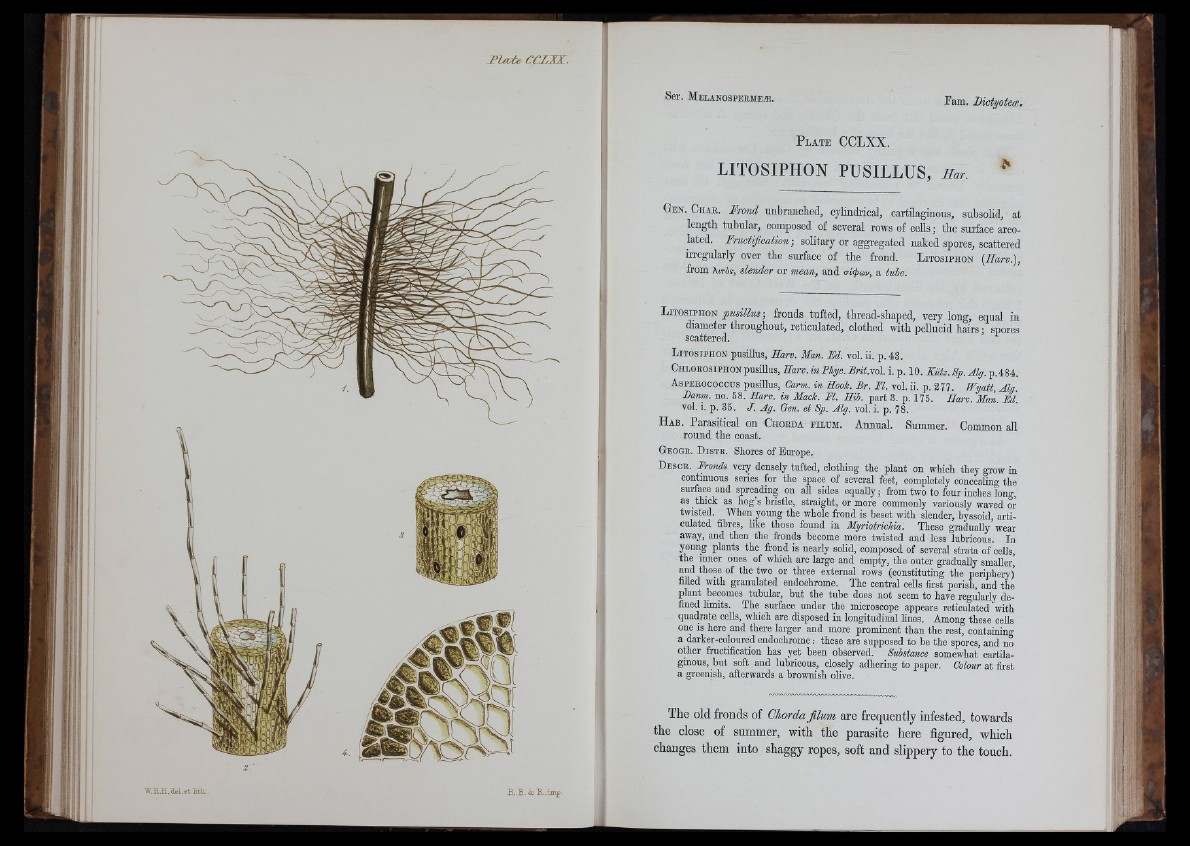
I
■W.HH.aíl.BtütK. OEl.B. ¿ü ït.iin£.
P l a t e CCLXX.
LITOSIPHON PUSILLUS, H a r .
G e n . Ch a r . Frond unbranched, cylindrical, cartilaginous, subsolid, at
length tubular, composed of several rows of cells; the surface areolated.
Fructification-, solitary or aggregated naked spores, scattered
irregularly over the surface of the frond. L ito siph o n (Harv.),
from Xiror, slender or mean, and aitjx.iv, a tube.
L ito s iph o n ; fronds tufted, thread-shaped, very long, equal in
diameter tliroughout, reticulated, clothed with peUucid hairs : spores
scattered.
L i t o s i p h o n pusiUus, Harv. Man. Fd. vol. ii. p. 43.
C h l o e o s i p h o n pusiUus, Harv. in Phyc. Brit.Yol. i. p. 10. Kütz. Sp. Alg. p. 484.
A s p e e o c o o o u s pusiUus, Carm. in Hook. Br. FI. vol. ii. p. 277. Wyatt, Alg
Banm. uo. 58. Harv. in Mack. FI. Hib. part 3. p. 175. Harv. Man. Fd.
vol. 1. p. 35. J. Ag. Gen. et Sp. Alg. vol. i. p. 78.
H ab. Parasitical on Chorda e ilum . Annual. Summer. Common all
round the coast.
G e o g e . D i s t e . Shores of Europe.
D e s c e . Fronds veiy densely tufted, clothing the plant on which they grow in
continuous series for the space of several feet, completely concealing the
surface and spreading on all sides equally; from two to four inches Ion»-,
as thick as hog’s bristle, straight, or more commonly variously waved or
twisted. When young the whole frond is beset with slender, byssoid, articulated
fibres, like those found in Myriotrickia. These gradually wear
away, and then the fronds become more twisted and less lubricous. In
young plants the frond is nearly solid, composed of several strata of ceUs,
the inner ones of which are large and empty, the outer gradually smaller!
and those of the two or thi-ee external rows (constituting the periphery)
filled with granulated endochrome. The central cells first perish, and the
plant becomes tubular, but the tube does not seem to have regularly defined
limits. The surface under the microscope appears reticulated with
quadrate ceUs, which are disposed in longitudinal lines. Among these ceUs
one IS here and there larger and more prominent than the rest, containing
a darker-coloured endochrome : these are supposed to be the spores, and no
other fructification has yet been observed. Substance somewhat cartila-
gmous, but soft and lubricous, closely adhering to paper. Colour at fast
a greenish, afterwards a brownish olive.
The old fronds of Chorda J ilum are frequently infested, towards
the close of summer, with the parasite here figured, which
changes them into shaggy ropes, soft and slippery to the touch.
f i t?
ii '
I
I i
I I .
i '